Key Takeaways
- Selling as-is means offering your property in its current condition without making repairs.
- Proper pricing and transparency are crucial to attract serious buyers.
- Enhancing curb appeal and decluttering can make a significant difference.
Selling a home can feel overwhelming, especially when faced with the prospect of repairs, staging, and endless showings. For many homeowners, the traditional route of fixing every flaw before listing can be time-consuming, costly, and emotionally draining. The good news is that there are ways to simplify the process without sacrificing your goals, allowing you to move forward confidently and efficiently.
One of the most effective strategies is to sell your property in its current condition, avoiding the headaches of renovations and contractor delays. This approach is particularly appealing if you aim for a quick sale, as it eliminates the extra steps that slow down the process. By removing the repair burden, you can streamline the transaction and shift your attention to your next chapter.

Understand the Implications of Selling As-Is
Selling your house as-is means presenting it to buyers in its current state, without making improvements or repairs. This approach can be especially appealing when time is of the essence or if you lack the resources or desire to tackle renovations. However, it’s essential to accept that buyers expect discounted pricing, accounting for the repair work they must handle themselves. While you might come ahead by saving on upfront costs, your sale price may reflect the property’s condition.
Set a Competitive and Realistic Price
Setting a fair and realistic price is essential for a smooth, no-repair home sale. Overpricing can deter serious buyers, while underpricing leaves money on the table—research recent sales of similar properties in your area to understand market trends and buyer expectations. A well-priced home attracts more interest, shortens time on the market, and reduces the stress of drawn-out negotiations. For many sellers, offering a cash deal can effectively stand out, appealing to buyers who value a faster closing process. By balancing competitiveness with market reality, you can secure a sale that meets both speed and value goals.
Enhance Curb Appeal and Declutter
First impressions are powerful, even when selling as-is. Simple tasks like mowing the grass, trimming hedges, and clearing walkways signal to buyers that the property has been maintained, even if it needs further updates. Likewise, decluttering each room and doing a deep clean allows visitors to imagine the home’s potential. The more welcoming the space, the more attractive it is to prospective buyers—often resulting in higher and faster offers.
Disclose All Known Issues Transparently
Listing your home as-is doesn’t exempt you from disclosing issues like roof leaks, outdated plumbing, or electrical faults. Honest, thorough disclosure builds trust and prevents future legal conflicts. Some sellers opt for pre-listing inspections to set clear expectations. Transparency enhances your position and can ease negotiations.
Market Strategically to the Right Audience
As-is properties often appeal to specific buyer pools: investors seeking renovation projects, flippers, or buyers searching for affordable homes with potential. Tailoring your listing’s marketing—highlighting the challenges and the property’s unique features, location, and upside—can help attract motivated buyers. Using online real estate platforms and supplementing with local advertisements or investor networks will maximize your reach.
Prepare Necessary Documentation in Advance
Organizing all required paperwork before listing will prevent unexpected delays as you approach closing. Secure documents such as the property’s title deed, tax statements, and warranties or manuals for included appliances. Everything readily available signals professionalism and reliability to buyers, increasing their willingness to move quickly and decisively.



